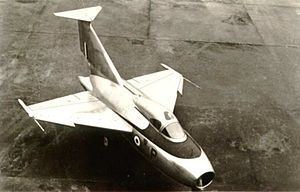Top speed 555 km/h Length 8 m | Wingspan 5.9 m Retired 1953 First flight March 12, 1951 | |
 | ||
Manufacturers Avions Fairey, Fairey Aviation Company | ||
The Fairey Delta 1 or FD1 was a British research aircraft produced by the Fairey Aviation Company for investigation of delta wing flight characteristics and control at transonic speeds. In testing, the FD1 exhibited unfavourable handling and stability leading to cancellation of two further airframes. It was the first British-designed delta wing.
Contents
Design and development
Originally conceived as a vertical takeoff (VTO) fighter, the proposed fighter was intended to be launched from an inclined ramp. Already in the early design stage at Fairey, the Ministry of Supply (MoS) decided to have the aircraft built as a more conventional jet-powered research vehicle to Ministry specification E.10/47. The Fairey Type R design was a mid-wing tail-less delta monoplane, with a circular cross-section fuselage and engine air-inlet at the extreme front. The engine was a Rolls-Royce Derwent 8 centrifugal turbojet. Although designed as a transonic aircraft, the Delta 1 had a short-coupled, "portly" appearance, completely at odds with Fairey's next design, the sleek and elegant Delta 2. Three aircraft were ordered with the name "Fairey Delta" applied to the project; subsequently, the name was changed to Fairey Delta 1.
Testing
The only FD1 to be completed was built at Fairey's Heaton Chapel Stockport factory and taken by road to their test facility at Manchester's Ringway Airport for final assembly. Starting on 12 May 1950 it made several high-speed taxi runs down the 4,200-foot main runway there before being partially dismantled and transported by road to the Aeroplane and Armament Experimental Establishment (AAEE) at RAF Boscombe Down. After further taxi tests, the aircraft (serial number VX350) made its maiden flight on 12 March 1951, flown by Fairey test pilot Group Captain Gordon Slade. The FD1 was fitted with a small horizontal delta-shaped control surface on the top of the tail-fin which was intended to stop the "serious pitching as it gathered speed." Continued testing pointed to serious stability problems that were characterized as "dangerous." The additional tail surface limited the top speed to a relatively pedestrian 345 mph (555 km/h).
After a landing accident in September 1951, the FD1 was modified with the removal of the temporary slots as well as the removal of the streamlined housings for the anti-spin parachutes that were mounted at the wingtips. The large control surfaces made the FD 1 difficult to control or even fly with precision although a rapid roll rate was achieved. Only one FD1 was built, with the second (VX357) and third (VX364) airframes being cancelled before they entered production.
Final years
Following the cancellation of the programme by the Air Ministry the aircraft continued to be flown on trials work by Fairey. On 6 February 1956 it was damaged beyond repair in a landing accident at Boscombe Down. The aircraft was moved in October 1956 for use as a target on the Shoeburyness weapons range and it was later scrapped. Fairey had spent £382,000 of their own money on the FD1.
Specifications (Fairey Delta 1)
Data from Jane's
General characteristics
Performance
